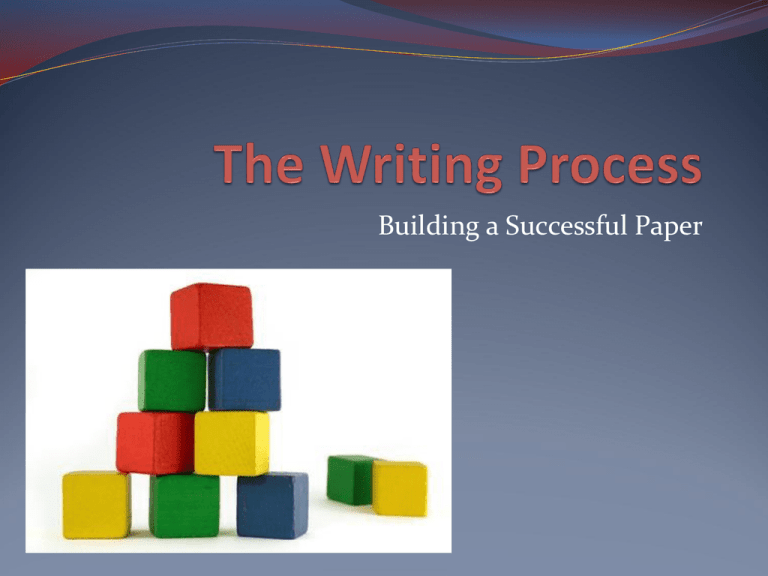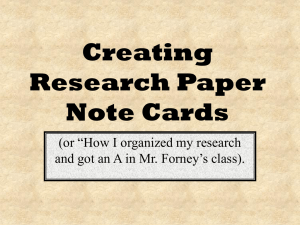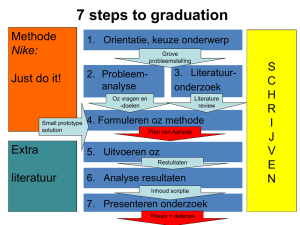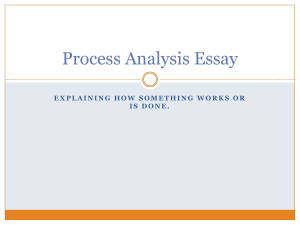The Writing Process
advertisement

Building a Successful Paper A Common Complaint Student writers don’t plan. They just sit down and start writing. Prewriting Gives you a Head Start! It involves: Planning Organizing And leads into: Drafting Prewriting Benefits Planning and organizing before you start writing doesn’t add work; it redistributes work. Yes, it will take longer to start writing, but… It will take less time to write the paper, and… Your paper will be much better! Planning Assess the writing situation Form a research question Research your topic from multiple viewpoints Draft a working thesis Assess the Writing Situation Before writing, all authors assess their situations. Here, we consider what we call a rhetorical triangle: Now, you’re the author! So you need to think about these things. Subject What am I writing about? What do I already know about this? What different points of view exist? Purpose What am I hoping to accomplish? Do I want to inform, persuade, analyze, etc.? Audience Who are you targeting with this paper? What assumptions can you make about this audience? Form a Research Question First, make sure you understand what your assignment asks. Read very carefully! Next, form a basic question that will guide your research. Should the government adopt a single-payer healthcare system? Are student/teacher conferences worth the time and inconvenience? Research Your Topic Pay attention to your assignment’s source requirements. Use the tools at your disposal. Library Internet Interviews Consider multiple points of view! Draft a Working Thesis Your thesis should: Answer your research question. Show where you stand on the issue. Show your audience where the paper will go. The success of single-payer healthcare systems in other nations suggests that America would benefit by adopting one as well. Student success begins at home, and the relationship between teachers and parents built in conferences is essential to fostering a home environment that is beneficial to education. Organizing An outline is a great way to organize. When organizing, break your paper down into three main parts: Intro Body Conclusion Outline You’ve seen these before. Thesis at the top. Each Roman numeral provides a main line of reasoning. Each subheading is support for that line of reasoning. Example Thesis: The success of single-payer healthcare systems in other nations suggest that America would benefit by adopting one as well. I. Health care in Switzerland I. II. III. Example from Jones article Quote from Swiss doctor Quote from EU official Health care in Canada II. I. II. Example from Jones Quote from Prime Minister Objections to Plan III. I. II. Quote from Sarah Palin Quote from Obama refuting Palin Drafting Your outline is like a skeleton… Put some meat on those bones! Plan an Introduction A good introduction should: Grab the reader’s attention Give background information and history, enough to get the reader up to speed on the issue This includes major points of view Introduce your thesis Body Paragraphs Each paragraph should contribute to supporting your thesis. Either by using sources to confirm your claims… Or by refuting claims that dispute your thesis. Open paragraphs with a topic sentence (similar to Roman numeral bullet from outline). Support with quotes, paraphrases, and summaries from research. Conclusion A good conclusion reiterates main ideas; it doesn’t repeat them. Emphasize your thesis. Remind us of key arguments. Close by returning to grabber to bring paper full circle. If you plan well… Writing the paper is as simple as elaborating on your outline! All you have to do is connect your main points. Saves time. Better organized. Won’t leave anything out. But what if… You have to write a very long paper? Time Plan early, start early. Your Working Thesis “I don’t know what I think until I see what I say.” Start with an Observation… “Many college students work full time.” Convert it to an Announcement… “In this paper I want to write about the fact that many college students work full time.” Pose a Question or Questions… “Why do so many college students have to work full time? Does this affect their grades?” Your paper will answer the question(s)! Begin to sculpt support At first... THERE WILL BE CHAOS! Find ways to organize data. Maps Gloss Paragraphs Color Code Too much information? Cut off a limb! Too little information? Thanksgiving Dinner Draft, supporting with quotes, paraphrases, and summaries. Avoid over-quoting and strings of direct quotes. Use your own voice. Paraphrase and summarize. Think conversation. Complete a rough draft. It doesn’t have to be pretty! Now, time for revision. Revision = RE-VISION Narrow your thesis. Now you can see what you say! Thesis is like a mini-outline. “Because many students work full time, they are unable to keep up their grade point averages, some with a 2.0 and under, so they risk future job opportunities because employers see poor grades on college transcripts.” Reverse Outline Logical organization? Supports thesis? Read for clarity. Will another reader understand each step of your argument? Are their logical transitions between sentences, paragraphs, and sections? Read out loud. Proofread Find another reader to help. Visit the Writing Center HPAC 136 503-5883 MWF 9:00-4:00; TR 10:00-5:00









